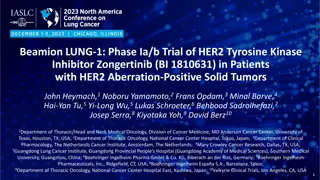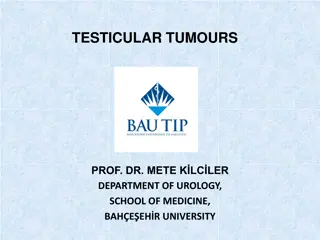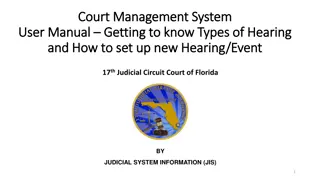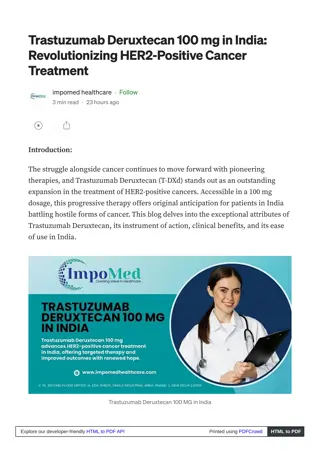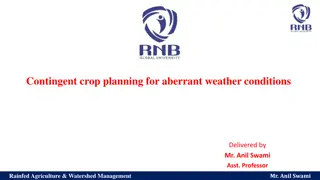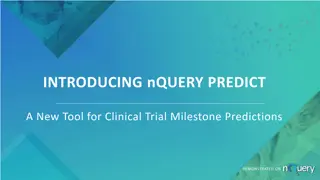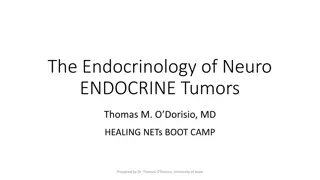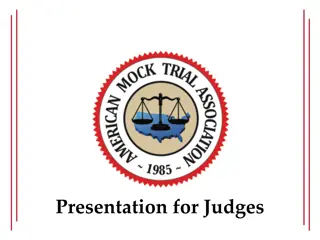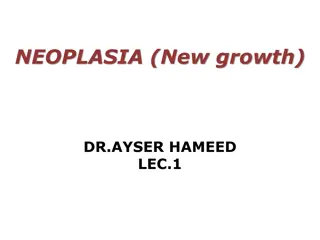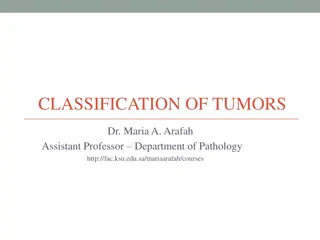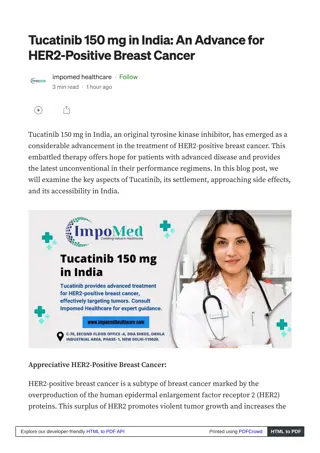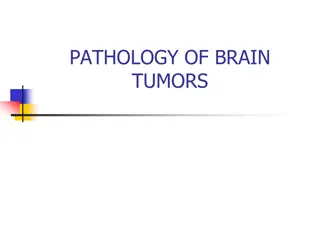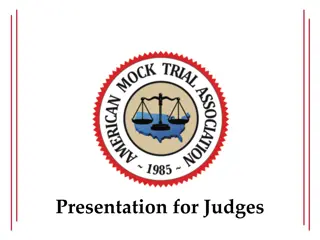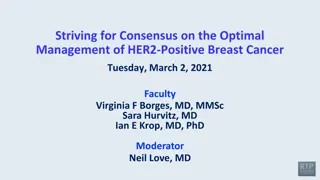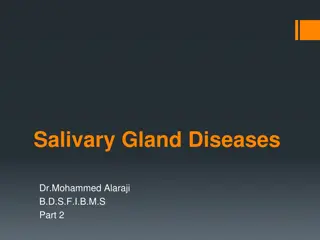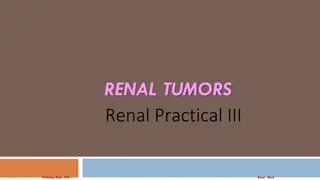Zongertinib Trial in HER2 Aberrant Tumors
Zongertinib (BI.1810631) Phase I Study in Advanced Solid Tumors with HER2 Aberrations focusing on NSCLC. The trial involves dose escalation and expansion, testing different doses in cohorts with varied HER2 mutations. Primary endpoints include MTD, OR, and DLTs.
Download Presentation

Please find below an Image/Link to download the presentation.
The content on the website is provided AS IS for your information and personal use only. It may not be sold, licensed, or shared on other websites without obtaining consent from the author. Download presentation by click this link. If you encounter any issues during the download, it is possible that the publisher has removed the file from their server.
E N D
Presentation Transcript
BEAMION LUNG-1, A PHASE IA/IB TRIAL OF THE HER2 TKI, ZONGERTINIB (BI 1810631), IN PATIENTS WITH ADVANCED SOLID TUMORS WITH HER2 ABERRATIONS Noboru Yamamoto,1 Frans Opdam,2 Minal Barve,3 Hai-Yan Tu,4 Yi-Long Wu,4 David Berz,5 Lukas Schroeter,6 Behbood Sadrolhefazi,7 Josep Serra,8 Kiyotaka Yoh,9 John Heymach10 1National Cancer Center Hospital, Tokyo, Japan; 2The Netherlands Cancer Institute, Amsterdam, The Netherlands; 3Mary Crowley Cancer Research, Dallas, TX, USA; 4Guangdong Lung Cancer Institute, Guangdong Provincial People s Hospital (Guangdong Academy of Medical Sciences), Southern Medical University, Guangzhou, China; 5Valkyrie Clinical Trials, Los Angeles, CA, USA; 6Boehringer Ingelheim Pharma GmbH & Co. KG, Biberach, Germany; 7Boehringer Ingelheim Pharmaceuticals, Inc., Ridgefield, CT, USA; 8Boehringer Ingelheim Espa a S.A., Barcelona, Spain; 9National Cancer Center Hospital East, Kashiwa, Japan; 10MD Anderson Cancer Center, University of Texas, Houston, TX, USA 1. Noboru Yamamoto, National Cancer Center Hospital, Tokyo, Japan
Beamion Beamion LUNG LUNG- -1 (NCT04886804): trial design/endpoints 1 (NCT04886804): trial design/endpoints Zongertinib (BI 1810631) is a novel tyrosine kinase inhibitor that covalently and selectively binds to the TKD of HER2, and is under investigation as an oral treatment for NSCLC tumors harboring HER2 TKD mutations, including ex20ins mutations Phase Ia: dose escalation Phase Ib: dose expansion (in patients with HER2 mutation-positive NSCLC) (in patients with advanced solid tumors with HER2aberrations*) Cohort 1 Cohort 1 One oral dose, BID, 3-week cycles Interim futility analyses Cohort 2 Cohort 2 Cohort 5 Cohort 5 150 mg n=~36 patients Cohort 3 (experimental) Cohort 4 (experimental) 100 mg 60 mg 30 mg 360 mg Ongoing 15 mg Cohort 1: Pre-treated NSCLC with a HER2 TKD mutation 300 mg Planned 240 mg Cohort 2: Treatment-na ve NSCLC with a HER2 TKD mutation 180 mg 120 mg Cohort 3: NSCLC with a non-TKD HER2 mutation n=~30 patients 60 mg NSCLC with a HER2 TKD mutation and active brain metastases Cohort 4: One oral dose, QD, 3-week cycles NSCLC with a HER2 TKD mutation and prior treatment with HER2 directed antibody drug conjugates Cohort 5: 2. *Overexpression, amplification, somatic mutation, or gene rearrangement involving HER2 or NRG1; Excluding patients treated with antibody drug conjugates. Phase Ia primary endpoint: MTD and DLTs (MTD evaluation period); Phase Ib primary endpoint: OR, according to RECIST v1.1. BID, twice daily; DLTs, dose-limiting toxicities; HER2, human epidermal growth factor receptor 2; MTD, maximum tolerated dose; NRG1, neuregulin 1; NSCLC, non-small cell lung cancer; QD, once daily; TKD, tyrosine kinase domain Noboru Yamamoto, National Cancer Center Hospital, Tokyo, Japan
Phase Ia baseline characteristics Phase Ia baseline characteristics Characteristic Phase Ia (N=50) Characteristic Total (N=50) Median age, years (range) 60.5 (31 79) Diagnosis, n (%) Male sex, n (%) 26 (52.0) NSCLC 31 (62.0) Race, n (%) Lung cancer, unspecified 4 (8.0) White 17 (34.0) Colorectal cancer 3 (6.0) Asian 32 (64.0) Endometrial cancer 2 (4.0) ECOG PS, n (%) Other tumors 8 (16.0) 0 17 (34.0) HER2 aberration, n/N tested (%) 1 33 (66.0) Mutation 28/48 (58.3) Previous lines of therapy, n (%)* Amplification 4/5 (80.0) 2 20 (40.0) Overexpression 9/12 (75.0) >2 26 (52.0) Rearrangement involving HER2 or NRG1 10/48 (21.0) Data cut off: July 17 2023. *Four patients (8.0%) had missing data; two patients (4.0%) had missing data; 1+, 2+, or 3+ on immunohistochemistry. ECOG PS, Eastern Cooperative Oncology Group Performance Status; HER2, human epidermal growth factor receptor 2; NRG1, neuregulin 1; NSCLC, non-small cell lung cancer 3. Noboru Yamamoto, National Cancer Center Hospital, Tokyo, Japan
Phase Ia dose escalation and safety Phase Ia dose escalation and safety One DLT during MTD evaluation period (i.e. Cycle 1; 360 mg QD, Grade 3 platelet count decreased) Zongertinib BID (n=17) Zongertinib QD (n=33) Total (N=50) MTD not reached with either BID or QD schedule Phase Ia TRAEs (%*) Any 76.5 Grade 3 5.9 Any 84.8 Grade 3 12.1 Any 82.0 Grade 3 10.0 Any TRAE Three DLTs during the on-treatment period (i.e. beyond Cycle 1) Diarrhea 47.1 36.4 40.0 AST increased 5.9 18.2 3.0 14.0 2.0 Doses taken into dose optimization are 240 mg and 120 mg QD Rash 11.8 15.2 14.0 ALT increased 5.9 5.9 15.2 6.1 12.0 6.0 One discontinuation due to TRAE (Grade 3 ALT increased) Paronychia 5.9 12.1 10.0 Dry skin 11.8 6.1 8.0 One patient with serious TRAEs (Grade 3 ALT increase and AST increase) Anaemia 11.8 6.1 8.0 4. Data cut off: July 17 2023. * 8% of total patients; Combined term, includes rash, rash maculo-papular, dermatitis acneiform. ALT, alanine aminotransferase; AST, aspartate aminotransferase; BID, twice daily; QD, once a day; TRAEs, treatment-related adverse events Noboru Yamamoto, National Cancer Center Hospital, Tokyo, Japan
Antitumor response in Phase Antitumor response in Phase Ia Ia Best change from baseline in target lesions (%)* 100 Overall (N=46)* ORR: 41.3% DCR: 91.3% NSCLC (n=34)* ORR: 50.0% DCR: 97.1% NSCLC 80 62% Other 60 Patients still on treatment at data cut off 40 Patients 20 0 7.5 (1 24) Median number of cycles (range) -20 PR SD PD -40 -60 Ongoing Esophagus Biliary tract -80 500 0 50 100 150 200 250 300 350 400 450 -100 Time since treatment start (days) 5. Data cut off: July 17 2023. *Patients with 1 post-baseline tumor assessment or discontinued before first assessment for any reason. DCR, disease control rate; NSCLC, non-small cell lung cancer; ORR, objective response rate; PD, progressive disease; PR, partial response; SD, stable disease Noboru Yamamoto, National Cancer Center Hospital, Tokyo, Japan
Phase Ib baseline characteristics and preliminary safety Phase Ib baseline characteristics and preliminary safety Characteristic Phase Ib (N=42) To date, 42 patients have been treated in Phase Ib in Cohort 1 Median age, years (range) 62.0 (34 80) Female sex, n (%) 22 (52.4) Phase Ib TRAEs (%*) Any Grade 3 One patient with dose reduction due to TRAEs (Grade 3 febrile neutropenia and neutrophil count decreased) Any TRAE 66.7 9.5 Diarrhea 28.6 - No discontinuations due to adverse events (any cause) Rash 21.4 - AST increased 9.5 2.4 Two patients with serious TRAEs (Grade 3 ALT increase and AST increase, Grade 4 immune thrombocytopenia and neutrophil count decreased) Decreased appetite 9.5 - Dysgeusia 9.5 - 6. Data cut off: July 31 2023. * 8% of total patients; Combined term, includes rash, rash maculo-papular, rash macular and dermatitis acneiform. ALT, alanine aminotransferase; AST, aspartate aminotransferase; TRAEs, treatment-related adverse events Noboru Yamamoto, National Cancer Center Hospital, Tokyo, Japan
Antitumor activity in Antitumor activity in Phase Ib Phase Ib Overall (N=23)* Best change from baseline in target lesions (%) 100 The first interim analysis in Cohort 1 was passed 80 73.9% (53.5, 87.5) ORR (95% CI): 60 Patients included in the efficacy analysis all had between 2 5 cycles of treatment at cut off 40 20 DCR: 91.3% 0 -20 Median best percentage change from baseline in target lesions: -41.2% -40 -60 -80 -100 7. Data cut off: July 31 2023. *Patients that started treatment at least 7 weeks prior to the snapshot date; patients that started treatment at least 7 weeks prior to the snapshot date with baseline and post-baseline tumor assessments. CI, confidence interval; DCR, disease control rate; ORR, objective response rate Noboru Yamamoto, National Cancer Center Hospital, Tokyo, Japan
Conclusions Conclusions In Phase Ia, the MTD of zongertinib was not reached Doses taken into dose optimization are 240 mg and 120 mg QD Zongertinib was well tolerated with low rates of EGFR-mediated adverse events Zongertinib demonstrated encouraging preliminary antitumor activity in various tumors with HER2- aberrations in Phase Ia Very promising initial efficacy results were observed in pre-treated patients with NSCLC with HER2 TKD mutations in Phase Ib The trial is ongoing 8. EGFR, epidermal growth factor receptor; HER2, human epidermal growth factor receptor 2; MTD, maximum tolerated dose; QD, once daily; TKD, tyrosine kinase domain Noboru Yamamoto, National Cancer Center Hospital, Tokyo, Japan
Acknowledgements Acknowledgements The authors thank the patients and their families, as well as the investigators and staff at the participating sites This study was funded by Boehringer Ingelheim The authors were fully responsible for all content and editorial decisions, were involved at all stages of development, and have approved the final version of this presentation The authors did not receive payment related to the development of this presentation Medical writing support for the development of this presentation, under the direction of the authors, was provided by Hannah Simmons MSc, of Ashfield MedComms, an Inizio Company, and funded by Boehringer Ingelheim 9. Noboru Yamamoto, National Cancer Center Hospital, Tokyo, Japan
HER2 HER2 mutations occur in many solid tumors mutations occur in many solid tumors HER2 mutation frequencies in solid tumors1 Distribution of HER2 mutations2 Esophageal (4 8%) Head and neck (2%) Lung (2 4%) Skin (2 7%) Pancreatic (1 2%) Breast (3 4%) Bladder (12 13%) Colorectal (5 6%) Cervical (3 6%) Prostate (1%) HER2 mutations occur across the gene, but the TKD is a hotspot, with ~50% of all mutations2,3 Of all HER2 TKD mutations, 90% are ex20ins mutations1 Ex20ins mutations have traditionally been resistant to TKIs1 Ex20ins, exon 20 insertion; HER2, human epidermal growth factor receptor 2; TKD, tyrosine kinase domain; TKI, tyrosine kinase inhibitor. 1. Baraibar I, et al. Crit Rev Oncol Hematol 2020;148:102906; 2. Hyman DM, et al. Nature 2018;554:189 94; 3. Robichaux JP, et al. Cancer Cell 2019;36:444 57. 1. Noboru Yamamoto, National Cancer Center Hospital, Tokyo, Japan
Mechanism of action of Mechanism of action of zongertinib zongertinib Previous ErbB TKIs Zongertinib HER2 TKD mutations, including ex20ins HER2 TKD mutations, including ex20ins Tumor cell Wild-type HER2 Mutant HER2 Wild-type EGFR Wild-type EGFR Wild-type HER2 Mutant HER2 Limited activity against ex20ins Active against ex20ins Wild-type EGFR blocked Wild-type EGFR sparing Fewer adverse events expected More adverse events expected Common adverse events caused by blocking EGFR Skin Gastrointestinal 2. EGFR, epidermal growth factor receptor Noboru Yamamoto, National Cancer Center Hospital, Tokyo, Japan
Phase Phase Ia Ia dose escalation and DLTs dose escalation and DLTs Number of patients (N=43) 3 3 4 4 3 5 4 7 Patients with DLTs (on-treatment period) 1, Grade 2 edema 1, Grade 2 diarrhea Zongertinib dose, mg Zongertinib schedule 15 30 60 100 150 60 120 180 BID BID BID BID BID QD QD QD 1, Grade 3 elevated ALT, Grade 2 blood bilirubin increased, Grade 2 AST increased 1, Grade 3 platelet count decreased 240 300 360 QD QD QD 7 8 2 At data cut-off (July 17, 2023), the MTD had not been reached Zongertinib 240 mg or 120 mg QD are the doses chosen for Phase Ib 3. ALT, alanine aminotransferase; BID, twice daily; DLT, dose-limiting toxicities; MTD, maximum tolerated dose; QD, once a day Noboru Yamamoto, National Cancer Center Hospital, Tokyo, Japan
Phase Ia response to Phase Ia response to zongertinib zongertinib Best change from baseline in target lesions (%)* 100 Best overall treatment response, n (%) NSCLC (n=34)* Overall (N=46)* Overall (N=46)* ORR: 41.3% DCR: 91.3% NSCLC (n=34)* ORR: 50.0% DCR: 97.1% NSCLC 80 Other ORR 17 (50.0) 19 (41.3) 60 CR 0 (0) 0 (0) 40 PR 17 (50.0) 19 (41.3) 20 SD 16 (47.1) 23 (50.0) 0 DCR 33 (97.1) 42 (91.3) PD -20 1 (3.0) 4 (8.7) NE 1 (3.0) 4 (8.7) -40 -60 PR: 7/11 (63.6%) Esophagus Biliary tract -80 SD: 3/11 (27.3%) A775_G776 insYVMA (n=11 ) -100 PD: 1/11 (9.1%) Data cut off: July 17 2023. 4. *Patients with 1 post-baseline tumor assessment or discontinued before first assessment for any reason; Defined as patients who discontinued before first assessment for any reason; Patients where mutation information was provided by the sites (which was optional in Phase Ia). BTC, biliary tract cancer; CR, complete response; DCR, disease control rate; NE, not evaluable; NSCLC, non-small cell lung cancer; ORR, objective response rate; PD, progressive disease; PR, partial response; SD, stable disease. Noboru Yamamoto, National Cancer Center Hospital, Tokyo, Japan
Beamion BeamionLUNG LUNG- -1: Current status 1: Current status Recruiting for Phase Ib in the following countries: Australasia and Asia Australia China Hong Kong Japan Singapore South Korea Europe and Middle East Austria Belgium France Germany Israel Italy The Netherlands Portugal Spain Sweden UK North America USA 5. Noboru Yamamoto, National Cancer Center Hospital, Tokyo, Japan




